Related Research Articles

Ayurveda is an alternative medicine system with historical roots in the Indian subcontinent. It is heavily practiced in India and Nepal, where around 80% of the population report using ayurveda. The theory and practice of ayurveda is pseudoscientific.
Vāgbhaṭa (वाग्भट) is one of the most influential writers, Scientist, Doctor and advisor of ayurveda. Several works are associated with his name as author, principally the Ashtāṅgasaṅgraha (अष्टाङ्गसंग्रह) and the Ashtāngahridayasaṃhitā (अष्टाङ्गहृदयसंहिता). The best current research, however, argues in detail that these two works cannot be the product of a single author. Indeed, the whole question of the relationship of these two works, and their authorship, is very difficult and still far from solution. Both works make frequent reference to the earlier classical works, the Charaka Samhita and the Sushruta Samhita. Vāgbhaṭa is said, in the closing verses of the Ashtānga sangraha to have been the son of Simhagupta and pupil of Avalokita. His works mention worship of Cows and Brahmanas and various Vedic Gods, he also begins with a note on how Ayurveda evolved from Brahma. His work contains syncretic elements.

Dhanvantari is the physician of the devas in Hinduism. He is regarded as an avatar of Vishnu. He is mentioned in the Puranas as the god of Ayurveda.

Dosha is a central term in Ayurveda originating from Sanskrit, which can be translated as "that which can cause problems", and which refers to three categories or types of substances that are believed to be present conceptually in a person's body and mind. These Dosha are assigned specific qualities and functions. These qualities and functions are affected by external and internal stimuli received by the body. Beginning with twentieth-century Ayurvedic literature, the "three-dosha theory" has described how the quantities and qualities of three fundamental types of substances called wind, bile, and phlegm fluctuate in the body according to the seasons, time of day, process of digestion, and several other factors and thereby determine changing conditions of growth, aging, health, and disease.
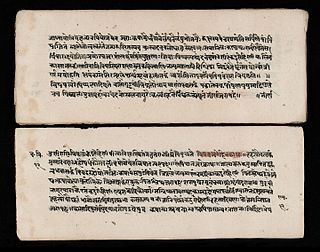
The Charaka Samhita is a Sanskrit text on Ayurveda. Along with the Sushruta Samhita, it is one of the two foundational texts of this field that have survived from ancient India. It is one of the three works that constitute the Brhat Trayi.
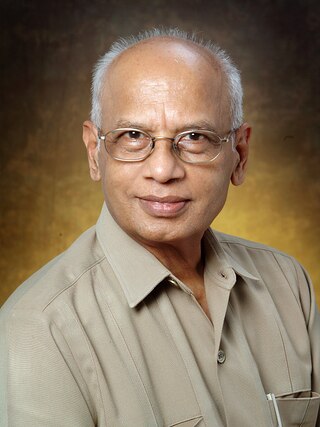
Marthanda Varma Sankaran Valiathan is an Indian cardiac surgeon. He is a former President of the Indian National Science Academy and National Research Professor of the Government of India.
Seevolli Narayanan Nambudiri (1868–1905) was a well-known Malayali poet of the Venmani style, who was also an Ayurvedic physician.
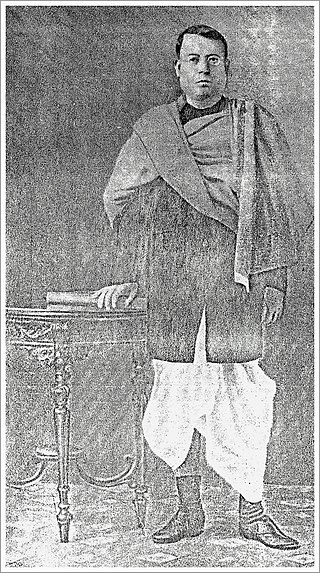
Jamini Bhushan Ray was an Indian physician, as well as an Ayurvedic doctor (Kabiraj), an erudite Sanskrit scholar, and a philanthropist.

Vaidyaratnam Oushadhasala is an Ayurvedic Pharmaceutical company situated in Thaikkattussery, near Ollur. It is managed by Thaikkattusseri Eledathu Thaikkattu Family, one among the Ashtavaidya families of Kerala. Vaidyaratnam runs a NABH accredited nursing home by name Vaidyaratnam Nursing Home and an Ayurvedic Medical College apart from two ISO certified manufacturing plants in Thrissur and an R&D centre in Thaikkattussery, under the flagship of Vaidyaratnam. .
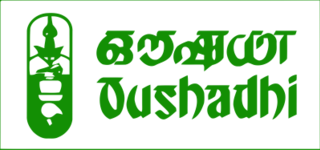
Oushadhi or Pharmaceutical Corporation Kerala Ltd is an Ayurvedic medicine manufacturing company situated in Kuttanellur, in Thrissur City of Kerala state. It is a fully Government of Kerala owned company and produces around 450 ayurvedic formulations.
Vaidyaratnam P. Sankunni Varier was an Ayurveda practitioner from what is now Kerala, India. He is well-regarded as the founder of Kottakkal Arya Vaidya Sala, a major Ayurvedic treatment centre in Kerala.
Eledath Thaikkattu Narayanan Mooss was an Ayurvedic physician and the Chief Physician and Managing Partner of Vaidyaratnam Oushadhasala. He was awarded the Padma Bhushan in 2010 for his contribution to the field of medicine specific to Ayurveda.
Mezhathur is an Indian village in the state of Kerala situated at Pattambi taluk of Palakkad district at the border of Thrissur, Malappuram and Palakkad districts. It is a historical and cultural village in Kerala. It is known for traditional Ayurveda physicians like Chatharu Nair and Vaidyamadom Valiya Narayanan Namboodiri. It is also the native place of renowned writer and social reformer V. T. Bhattathiripad. It is also the Birth place of Renowned Sanskrit Scholar and Critic M.P. Sankunni Nair.

Panniyampally Krishnankuty Warrier was an Indian Ayurveda practitioner. He was born in Kottakkal, Malappuram district in the Indian state of Kerala. He was the chief Physician and Managing trustee of Arya Vaidya Sala. He was the youngest nephew of Vaidyaratnam P. S. Varier, the founder of Arya Vaidya Sala.

The Kaivalyadhama Health and Yoga Research Center, founded by Swami Kuvalayananda in 1924, is a spiritual, therapeutic, and research center with a specific aim to coordinate ancient yogic arts and tradition with modern science; he founded the journal Yoga Mimamsa at the same time. Kaivalyadhama is located in Lonavla, Maharashtra, India, with smaller branches elsewhere in India, France, and the United States.
Nasya is a Panchakarma treatment for body cleansing used in Ayurvedic medicine. Administration of drugs by the route of nasal cavity is termed as nasya, nāvana, nasya karma, etcetera are synonymous to nasya. Randomized controlled clinical trials have shown reduction in the signs and symptoms of cervical spondylosis by nasya. Clinical trials of nasya have been carried out for myopia. Pradhamana nasya is used by ayurvedic physicians and have been found useful to treat chronic sinusitis. Nasya is a sanskrit word, which means " related to nose". So in this Nasya therapy, ayurveda treatment is performed through the nostril. Ayurvedic medicine either in the oil or smoke forms is infused into the nostrils. Nasya panchakarma therapy is very useful to address the disease related to head region, e.g. insomnia, stress, anxiety, early greying of hair, allergies.
Rajagopalan Krishnan Vaidyan was an Indian ayurvedic practitioner from the Indian state of Kerala and the president of the Association of Ayurvedic Physicians of Kerala.
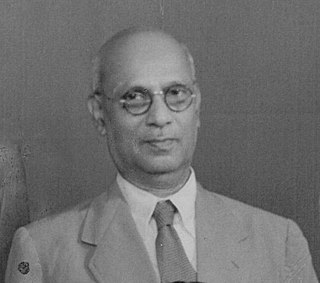
Dr. L. A. Ravi Varma, was a historian, ophthalmologist and philosopher of the 20th century in Kerala, India. He was a critical figure who enriched the Ayurvedic literature contributing to its renaissance. In January 1940, he was appointed as Director of the joint Oriental Manuscripts Libraries of the Government of Kerala and the Kerala University. He was conferred the Honorary Title of Vaidyashastra Nipunan and Gaveshana Thillakan by Chithira Thirunal Maharaja, the King of Travancore, Kerala, India.
Vaidya Balendu Prakash is an Indian Ayurveda practitioner. He is a former physician to the President of India and the founder of Paadav, a specialty Ayurvedic hospital in Dehradun. The Government of India awarded him the fourth highest civilian award of the Padma Shri in 1999.
P. R. Krishna Kumar was an Indian Ayurveda expert and managing director of The Arya Vaidya Pharmacy (Coimbatore) Ltd. He founded the AVP Research Foundation, a non-profit organisation promoting research in the Ayurveda. He was the chancellor of the Avinashilingam University, and the chairman of CARe Keralam, a resource centre involved in efforts to standardise Ayurvedic medicines. The Government of India awarded him the fourth-highest civilian honour of the Padma Shri, in 2009, for his contributions to Ayurveda.
References
- ↑ "Namboothiri Ashtavaidyans". www.namboothiri.com -Namboothiri Trust. Retrieved 2022-05-17.
- 1 2 3 Indudharan Menon, Annamma Spudich (October 2010). "The Ashtavaidya physicians of Kerala: A tradition in transition". Journal of Ayurveda and Integrative Medicine. 1 (4): 245–50. doi: 10.4103/0975-9476.74424 . PMC 3117315 . PMID 21731370 . Retrieved 10 November 2016.
- ↑ V. T. Yadugiri (25 August 2010). "The Ashtavaidya medical tradition of Kerala" (PDF). Current Science. 99 (4). Retrieved 10 November 2016.
- ↑ P. U. Leela (January 2013). "Healers in the context of culture: The ashtavaidya tradition of Kerala, South India". Ancient Science of Life. 32 (S9): S9. doi: 10.4103/0257-7941.123821 . PMC 4147565 .
- ↑ Dr. K. M. Namboodiri. "Ashtavaidyans". Namboothiri Website Trust. Retrieved 10 November 2016.
- ↑ P. U. Leela (2008). Religious beliefs and medical practices: a sociological study of ashtavaidyas of Kerala. New Delhi: Jawaharlal Nehru University. hdl:10603/14439 . Retrieved 10 November 2016. (thesis submitted to Jawaharlal Nehru University for the award of PhD degree).